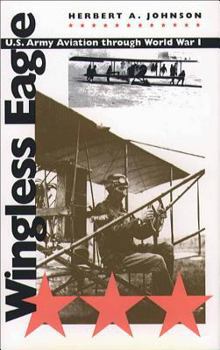Wingless Eagle: U.S. Army Aviation Through World War I
Select Format
Select Condition 
Book Overview
At the start of the twentieth century the United States led the world in advances in aviation, with the first successful engine-powered flights at Kitty Hawk, North Carolina, and Dayton, Ohio, beginning in 1903. Fifteen years later, however, American airmen flew European-designed aircraft because American planes were woefully inadequate for service on the Western Front. Why was the United States so poorly prepared to engage in aerial combat in World War I?
To answer this question, Herbert Johnson takes a hard look at the early years of U.S. military aviation, exploring the cultural, technical, political, and organizational factors that stunted its evolution. Among the recurring themes of Johnson's narrative are the damaging effects of a chronic lack of governmental funding for military aeronautics and the disruptive influence of a civilian "aeronaut constituency" both on military discipline and on public and Congressional attitudes toward army aviation. In addition, the Wright brothers' patent litigation hindered the technical development of American aircraft and crippled the domestic aviation industry's manufacturing capacity. Wartime experience helped correct some of these problems, but the persistence of others left the postwar Air Service with an uncertain and stormy future.
To answer this question, Herbert Johnson takes a hard look at the early years of U.S. military aviation, exploring the cultural, technical, political, and organizational factors that stunted its evolution. Among the recurring themes of Johnson's narrative are the damaging effects of a chronic lack of governmental funding for military aeronautics and the disruptive influence of a civilian "aeronaut constituency" both on military discipline and on public and Congressional attitudes toward army aviation. In addition, the Wright brothers' patent litigation hindered the technical development of American aircraft and crippled the domestic aviation industry's manufacturing capacity. Wartime experience helped correct some of these problems, but the persistence of others left the postwar Air Service with an uncertain and stormy future.
Format:Hardcover
Language:English
ISBN:0807826278
ISBN13:9780807826270
Release Date:September 2001
Publisher:University of North Carolina Press
Length:320 Pages
Weight:1.45 lbs.
Dimensions:1.0" x 6.1" x 9.3"
Customer Reviews
1 rating
"Wingless Eagle" flies high
Published by Thriftbooks.com User , 23 years ago
Much of the advancement of the science of aviation resulted from efforts to develop the airplane as a weapon of war but aside from the memoirs of some early "bird men" and biographies of a handful of other pioneer aviators little has been written about American aviation in the years before World War One. Considering the almost pathetic "state of the art" in this country prior to 1917-18 it is perhaps no surprise that the subject has received scant attention from historians, but virtually no attempts have been made to explain why the U.S was unable to exploit the technological breakthrough made by the Wright brothers. Wingless Eagle explores some of the social and political factors that affected American aviation in general and Army aviation in particular before the Great War.Realistically, the government was the only potential buyer of those primitive flying machines in any sort of quantity, but neither Congress nor the General Staff was easily convinced that the benefits would be worth the cost. The young military and naval fliers who thought otherwise constantly struggled to demonstrate the value of aviation to the voting public but more often than not the hardware simply was not up to the task.As the author (a law professor himself) discuses in some detail, one of the biggest obstacles was the Wrights themselves. Their bitterly contested-and expensive-patent infringement suits against Glenn Curtiss and others stunted the growth of the U.S. aircraft industry during its formative years. The author maintains that the Army overtly supported the Wright's position. Investors were justifiably leery, and without capital aircraft development stagnated. Another legal episode, the 1915 court martial of Lt. Col. Lewis Goodier, is used to point out flaws in the Signal Corps management of the fledgling Air Service as well as to illustrate how personal jealousy among the flying fraternity and internal service rivalries also contributed to the sorry state of affairs in Army aviation. The author also makes an interesting assessment of what he terms the "aeronaut constituency", the various clubs and associations formed by enthusiastic-and often wealthy and influential-aviation boosters. Many other factors that aided or impeded the development of Army aviation are explored as well.This is not a book about airplanes. (The caption on page 65 has the aviator at the controls of a "Wright Flyer", although he is grasping the steering wheel of what is clearly a Curtiss pusher.) Likewise, not much new light is shed on the operational aspects of Army aviation in those early years. The serious student of aviation history, however, will come away with a much better understanding of the complex military, political and personal interactions that determined the course of U.S. Army aviation through the end of the First World War.






